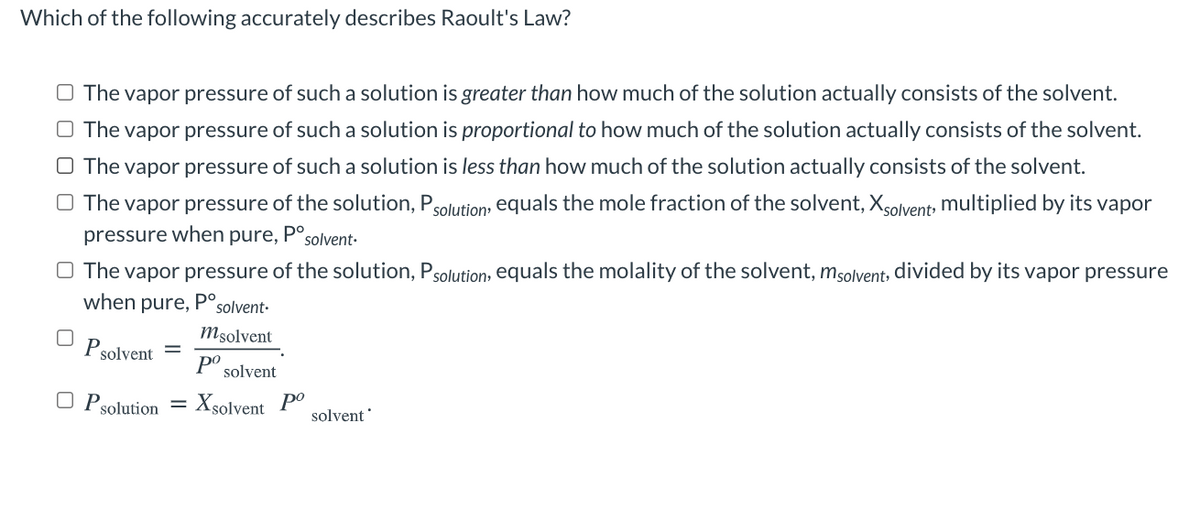Which of the following accurately describes Raoult's Law? O The vapor pressure of such a solution is greater than how much of the solution actually consists of the solvent. O The vapor pressure of such a solution is proportional to how much of the solution actually consists of the solvent. O The vapor pressure of such a solution is less than how much of the solution actually consists of the solvent. O The vapor pressure of the solution, Psolution, equals the mole fraction of the solvent, Xsolvent» multiplied by its vapor pressure when pure, P°s solvent- O The vapor pressure of the solution, Psolution, equals the molality of the solvent, msolvent, divided by its vapor pressure when pure, P°s solvent- Msolvent Psolvent po solvent Psolution = Xsolvent Po solvent
Which of the following accurately describes Raoult's Law? O The vapor pressure of such a solution is greater than how much of the solution actually consists of the solvent. O The vapor pressure of such a solution is proportional to how much of the solution actually consists of the solvent. O The vapor pressure of such a solution is less than how much of the solution actually consists of the solvent. O The vapor pressure of the solution, Psolution, equals the mole fraction of the solvent, Xsolvent» multiplied by its vapor pressure when pure, P°s solvent- O The vapor pressure of the solution, Psolution, equals the molality of the solvent, msolvent, divided by its vapor pressure when pure, P°s solvent- Msolvent Psolvent po solvent Psolution = Xsolvent Po solvent
Chemistry by OpenStax (2015-05-04)
1st Edition
ISBN:9781938168390
Author:Klaus Theopold, Richard H Langley, Paul Flowers, William R. Robinson, Mark Blaser
Publisher:Klaus Theopold, Richard H Langley, Paul Flowers, William R. Robinson, Mark Blaser
Chapter11: Solutions And Colloids
Section: Chapter Questions
Problem 65E: The vapor pressure of methanol, CH3OH, is 94 torr at 20 C. The vapor pressure of ethanol, C2H5OH, is...
Related questions
Question

Transcribed Image Text:Which of the following accurately describes Raoult's Law?
O The vapor pressure of such a solution is greater than how much of the solution actually consists of the solvent.
O The vapor pressure of such a solution is proportional to how much of the solution actually consists of the solvent.
O The vapor pressure of such a solution is less than how much of the solution actually consists of the solvent.
O The vapor pressure of the solution, Psolution, equals the mole fraction of the solvent, Xsolvent multiplied by its vapor
pressure when pure,
solvent-
O The vapor pressure of the solution, Psolution:, equals the molality of the solvent, msolvent, divided by its vapor pressure
when pure, P°solvent-
Msolvent
Psolvent =
po
solvent
O Psolution =
: Xsolvent Po
solvent
Expert Solution
This question has been solved!
Explore an expertly crafted, step-by-step solution for a thorough understanding of key concepts.
This is a popular solution!
Trending now
This is a popular solution!
Step by step
Solved in 2 steps

Knowledge Booster
Learn more about
Need a deep-dive on the concept behind this application? Look no further. Learn more about this topic, chemistry and related others by exploring similar questions and additional content below.Recommended textbooks for you

Chemistry by OpenStax (2015-05-04)
Chemistry
ISBN:
9781938168390
Author:
Klaus Theopold, Richard H Langley, Paul Flowers, William R. Robinson, Mark Blaser
Publisher:
OpenStax

Chemistry: An Atoms First Approach
Chemistry
ISBN:
9781305079243
Author:
Steven S. Zumdahl, Susan A. Zumdahl
Publisher:
Cengage Learning


Chemistry by OpenStax (2015-05-04)
Chemistry
ISBN:
9781938168390
Author:
Klaus Theopold, Richard H Langley, Paul Flowers, William R. Robinson, Mark Blaser
Publisher:
OpenStax

Chemistry: An Atoms First Approach
Chemistry
ISBN:
9781305079243
Author:
Steven S. Zumdahl, Susan A. Zumdahl
Publisher:
Cengage Learning


Chemistry
Chemistry
ISBN:
9781305957404
Author:
Steven S. Zumdahl, Susan A. Zumdahl, Donald J. DeCoste
Publisher:
Cengage Learning

Chemistry: Principles and Practice
Chemistry
ISBN:
9780534420123
Author:
Daniel L. Reger, Scott R. Goode, David W. Ball, Edward Mercer
Publisher:
Cengage Learning

Chemistry & Chemical Reactivity
Chemistry
ISBN:
9781133949640
Author:
John C. Kotz, Paul M. Treichel, John Townsend, David Treichel
Publisher:
Cengage Learning